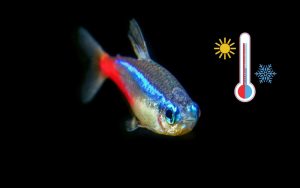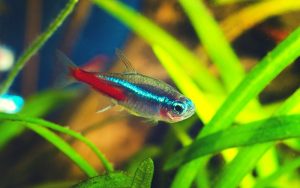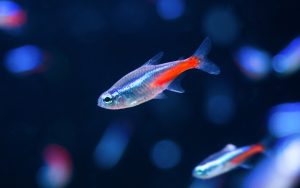Do ghost shrimp molt? It’s a common question, but the answer might surprise you. Molting is a critical process for aquatic species like the freshwater ghost shrimp, depending on their age and size.
Ghost shrimp, scientifically known as Palaemonetes spp., are popular freshwater crustaceans often kept in home aquariums.
They undergo molting to grow and regenerate their exoskeleton, allowing them to accommodate their increasing size.
While it might not be as apparent to spot as it is with other fish or larger crustaceans.
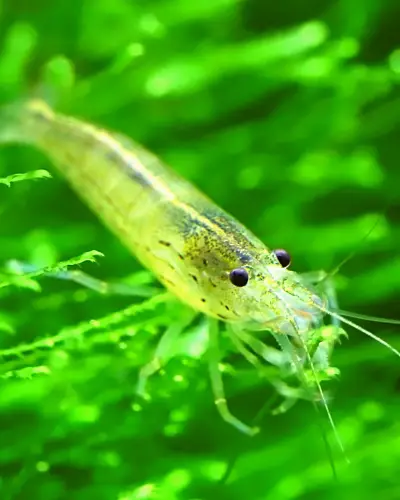
Understanding how Ghost Shrimp molt and taking steps to ensure they do so successfully can assist them in staying healthy and productive in your community tank.
In this blog post, we’ll explore the ghost shrimp molting behavior, understand its appearance, and learn how to provide optimal care during this critical period.
Find out five fundamental ideas to consider when providing good conditions for your Ghost Shrimp’s molting cycle — read on to learn more!
Table of Contents
ToggleWhat is molting?
Molting is a natural process where crustaceans shed their old exoskeleton to reveal a new, larger one. It’s similar to how snakes shed their skin.
During every molt stage, ghost shrimp temporarily become vulnerable until their new exoskeleton hardens.
Do shrimp shed their skin? Ghost shrimp typically molt every few weeks in their first year of life, depending on their age and size. After this period, the Ghost shrimp molting frequency can decrease every few months.
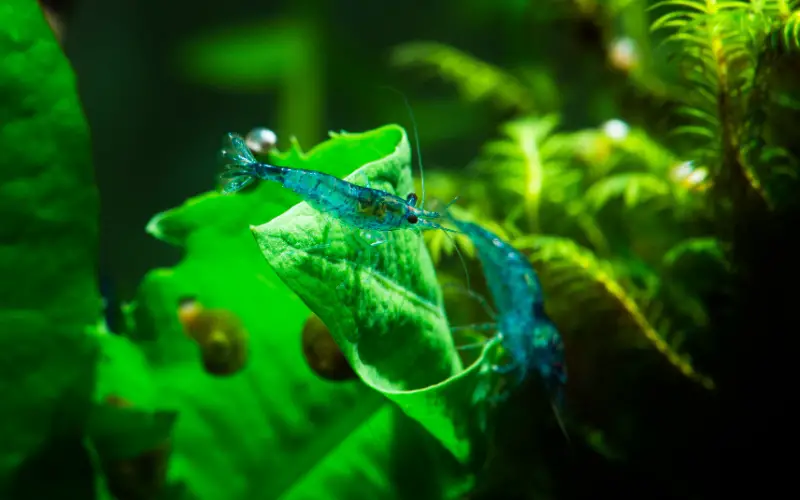
Recognizing the signs that a shrimp is about to molt is crucial to provide the most comfortable environment.
Do Ghost Shrimp Molt?
Do adult shrimps molt and shed their skin? Yes, ghost shrimp do molt. Molting is an important process for them to grow and regenerate their exoskeleton to accommodate their increasing size.
Why Do Ghost Shrimp Shed?
Why does ghost shrimp molt? Ghost shrimp shed for two primary reasons: growth and regeneration.
As they grow, their exoskeleton becomes restrictive, necessitating the shedding of the old shell to accommodate their increasing size.
Molting also allows ghost shrimp to regenerate lost appendages and repair any damage to their exoskeleton.
Are Ghost Shrimp Dead or Molting?
It can be harsh to determine whether a ghost shrimp is dead or molting, as they undergo a process of shedding their exoskeletons, which can look similar to death.
During molting, the ghost shrimp will shed its old exoskeleton and emerge with a new, soft exoskeleton that will harden over time. This shedding process can take several hours or even days.
If you notice a ghost shrimp lying motionless on the bottom of the aquarium, it could be either a molting or a dead shrimp. However, some signs can help you determine which is the case.
A dead ghost shrimp typically turns a gray or white ring of death, and its legs will become stiff and rigid. In contrast, a molting shrimp will still have some color, and its legs will be pliable and flexible.
Additionally, you may notice that a molting ghost shrimp turns white or has a cloudy or milky appearance caused by the shedding of its old exoskeleton.
If you are unsure whether your ghost shrimp is dead or molting, it’s best to wait and observe the shrimp for some time. If it is molting, it will eventually move and become active again. However, if it is dead, it will remain motionless and show no signs of life.
How Often Do Ghost Shrimp Molt?
The frequency of ghost shrimp molting varies depending on several factors, including age, size, and environmental conditions.
Generally, younger shrimp molt more frequently than older ones. On average, ghost shrimp molt every few weeks, which can be shorter or longer regarding individual shrimp and their environment.
How to Tell When a Ghost Shrimp Is Molting?
How to Know If My Ghost Shrimp Is Molting? The shrimp shows various indicators during the molt, including erratic behavior and frequent hiding. This is sometimes linked with microbial processes like the release of ammonia.
In addition, shrimp will become pale and appear to have cloudy eyes when molting.
You’ll notice a few physical signs when a ghost shrimp is about to molt. The ghost shrimp’s body part will become increasingly transparent, and its eyes may become cloudy or milky. The shrimp may also become sluggish and less active as it prepares for molt.
Once the molting process starts, the shrimp will leave its old exoskeleton behind and emerge with a new, soft exoskeleton.
5 Essential Considerations for Successful Ghost Shrimp Molting
As soon as you learn about the importance of molting a ghost shrimp, you must ensure the conditions are in place to perform successful molting. Here’s the essential element to be careful during a successful molting.
1. Ghost Shrimps Molting Behavior and Habitat
Ghost shrimp are known for their molting behaviors. During Ghost shrimp molting, they often seek hiding spots or burrow into the substrate to protect themselves while they are vulnerable. Providing appropriate hiding places, such as caves or plants, in their habitat allows them to molt comfortably without excessive stress.
2. Handling Molting Shrimp: Do’s and Don’ts during Molting
When you notice that a ghost shrimp is in the molting process, it’s important to handle the situation with care. Avoid disturbing the shrimp or attempting to remove the old exoskeleton forcefully. Allow the shrimp to complete the molting process naturally, as interfering can cause stress and potential harm.
3. Providing a Molting-Friendly Environment
Creating a molting-friendly environment for your ghost shrimp can contribute to successful molting. Ensure the ghost shrimp tank water parameters are stable, maintain good water quality, and provide a balanced diet. Additionally, offering a variety of hiding spots and soft substrates can assist in creating a safe and comfortable molting environment.
4. Recognizing a Recently Molted Ghost Shrimp
A recently molted ghost shrimp will have a soft and pale appearance. The new exoskeleton takes some time to harden and darken, gradually gaining its characteristic coloration. It’s important to give the shrimp time to adjust after molting and avoid introducing any potential stressors during this period.
5. Providing Optimal Conditions for Molting
Molting can be a stressful process for a ghost shrimp, so providing optimal conditions for molting is important so that the shrimp can successfully shed its old exoskeleton and form a new one.
Remember: Optimal conditions for molting include maintaining stable and consistent water parameters, such as appropriate water temperature, pH, and hardness, to avoid stress and ensure the shrimp can form a new exoskeleton.
Should I Remove Ghost Shrimp Molt?
It is generally recommended to leave ghost shrimp molts in the aquarium as they can provide a source of calcium for other tank inhabitants.
The exoskeleton of a molting ghost shrimp is rich in calcium, which is a vital nutrient for many aquatic animals, including snails and other crustaceans.
In addition to providing a source of calcium, leaving the molts in the aquarium can also help to reduce stress for the molting shrimp.
When a shrimp molts, it is vulnerable to predation and may hide for several hours until its new exoskeleton hardens. Leaving the molt in the aquarium can provide the shrimp with a natural hiding place and reduce its stress levels.
However, if you prefer to remove the molts from the aquarium, it is safe. Just be sure to remove them promptly to prevent them from decomposing and fouling the water.
How Many Times Does a Ghost Shrimp Molt?
The shrimp molts at least once a week; Young ghost shrimp molt at least once a week at a time. Baby shrimp molt or shed skin faster because they keep growing. Nevertheless, the frequency of ghost crab molting depends upon the special attention you have given.
By keeping your ghost shrimps well-fed, hydrated, and comfortably molted, you will get them molting more rapidly than possible. When adult shrimps are molted, they will have plenty of time, space, and emotional and physical support.
What Does Molting Shrimp Look Like?
What Does a Shrimp Look Like When It’s About to Molt? When a ghost shrimp is about to molt, its exoskeleton will appear duller and may even be discolored. Its eyes may become cloudy, and its body may swell slightly.
The Glass shrimp may also display unusual behavior, such as hiding or burrowing in the substrate more often than usual. The shrimp will remain still until shedding its old exoskeleton and emerging with a new one.
If you observe that your ghost shrimp has been stationary for an hour or more, they may be molting. This is the most common indication of molting ghost shrimps in this species.
Is Shrimp Molting a Good Sign?
It seems like shrimp molting has a positive effect. Because shrimps are grown, the shrimps will molt. Molting proves shrimps’ development, thus well. Shrimps are invertebrates. Then it becomes imperative that shrimp make exoskeletons for their protection.
When shrimps grow gradually, ghost shrimp shed the old exoskeleton before allowing it to grow again. Breeding habits for shrimp start when females have molted.
It releases into seawater. This chemical substance tells male shrimp if they’re ready for the mate. The scent attracts male fish and enables them to locate female shrimp within the pond.
Stages of the Ghost Shrimp Molting Process
Ghost shrimps have no growth processes like other water creatures growing continuously. Ghost shrimp grows in a series of phases, grouped as pre-molt and postmolt phases.
Sometimes ghost shrimp have been kept together. Determining which kind of ghost shrimp has lost their shells is challenging since they are very fragile.
Generally, a hobbyist can look inside the tank for minutes and see a few shrimp with clear white empty eggs at the top.
If there’s some shrimp there, everything should work fine. It is important to understand that Ghost Shrimp molts when eaten and growing. So as long as shrimp food and their feed are active, and the animals move around the house, molting occurs frequently.
Molting means that their health is good and that it will grow bigger. Ghost shrimps are extremely vulnerable once they’ve cooled off and are comfortable.
The Molting Process of Ghost Shrimp
Signs of molting
Before a ghost shrimp molts, several signs indicate that the process is imminent. These include decreased activity levels, loss of appetite, and the shrimp seeking hiding spots. As a responsible owner, observing these signs can help you prepare for the molting event.
Physical appearance during molting
When a ghost shrimp is molting, you may notice it is lying on its side or back, appearing motionless. Its exoskeleton will gradually split open, allowing the tiny shrimp within to wriggle out of its old shell. The newly exposed shrimp is soft and pale in color.
Factors Influencing the Molting Frequency of Ghost Shrimps
The molting frequency of ghost shrimp depends on several factors. If the aquarium water chemistry, temperature, and conditions are favorable for the ghost shrimp to molt, it will molt more often. Additionally, when ghost shrimps are fed properly and consistently, they can molt faster than usual.
Here are some significant factors that can affect the frequency of ghost shrimp molting:
Temperature and Water Quality
Maintaining stable water parameters and providing an appropriate temperature range is crucial for ghost shrimp healthy molting. Ghost shrimp prefer temperatures between 70°F and 82°F (21°C to 27°C) and require clean water with proper filtration to ensure optimal molting conditions.
Feeding and Nutrition
A well-balanced diet plan plays a significant role in the molting process of ghost shrimp.
Providing them with a diverse diet that includes high-quality shrimp pellets, fish flakes alone, and occasional treats like blanched vegetables or small live organisms can promote healthy molting.
A shrimp diet rich in calcium and other essential minerals is particularly important, as these nutrients form a strong new exoskeleton.
Age and Size
Younger ghost shrimp tend to molt more frequently as they experience rapid growth and development. As they mature and reach adulthood, the molting frequency may decrease. Larger ghost shrimp may also molt less frequently compared to smaller ones. Understanding the age and size of your shrimp can give you insights into their molting patterns.
The Importance of Molting for Ghost Shrimp
Molting is a vital process for ghost shrimp’s overall health and well-being. It allows them to grow, regenerate lost appendages, and replace damaged exoskeletons.
Regular and successful molting indicates that your shrimp are thriving and in a favorable environment. Keeping an eye on your ghost shrimp’s molting process can provide valuable insights into their overall health and well-being.
Challenges and Risks During Molting
While shrimp Molting is a natural process, it can pose challenges and risks for ghost shrimp. The vulnerability of a molting shrimp makes it more susceptible to predation or aggression from aggressive fish and unsuitable tank mates.
Monitoring the tank dynamics, providing appropriate tank mates, and ensuring a stress-free environment can minimize these risks.
Promoting Healthy Molting
Maintaining optimal water conditions is crucial to promote healthy molting in ghost shrimp. Regular water changes, proper filtration, and monitoring ammonia and nitrite levels are essential.
Offering a balanced diet, providing adequate hiding spots, and avoiding sudden environmental changes also contribute to healthy molting.
Dealing with failed molts
Sometimes, ghost shrimp may encounter difficulties during molting, resulting in unsuccessful molting. A failed molt occurs when the shrimp cannot shed its old exoskeleton completely or gets trapped.
If you notice a shrimp experiencing difficulty or showing signs of distress during molting, consult a knowledgeable aquatic specialist for assistance.
Frequently Asked Questions about Ghost Shrimp Molting (FAQs)
Here are some common questions related to ghost shrimp molting:
Do Ghost Shrimp Eat Their Molt?
Yes, suppose you leave the ghost shrimp shell in the tank. In that case, they will happily consume it since it is an excellent supply of calcium, which is particularly helpful while attempting to develop a new exoskeleton.
Do Ghost Shrimp Die After Molting?
Ghost shrimp do not typically die after molting, but the process can be stressful for them, and they may become more vulnerable to predation during this time. When a ghost shrimp molts, it sheds its old exoskeleton and emerges with a new, soft exoskeleton that will harden over time.
Do Ghost Shrimp Look Dead When They Molt?
Ghost shrimp can look dead when they molt because, during the molting process, they shed their old exoskeleton and emerge with a new, soft exoskeleton that can make them appear pale, limp, and lifeless.
How Long Does the Molting Process Typically Last for Ghost Shrimp?
The molting process can take several hours to several days, depending on the shrimp’s size and specific conditions. After molting, it takes some time for the new exoskeleton to harden completely.
Is It Normal for Ghost Shrimp to Eat Their Old Exoskeleton After Molting?
Yes, it is common for ghost shrimp to consume their old exoskeleton. It supplies them with a source of nutrients, particularly calcium, which aids in forming the new exoskeleton.
What Is Osmotic Shock in Shrimp?
Osmotic shock is a condition that can occur in shrimp when there is a sudden and significant change in the salinity level of the water. Like other aquatic creatures, shrimp have a natural balance of water and salts in their bodies and tissues.
What I Should Do if I Find an Empty Exoskeleton in the Tank?
Finding an empty exoskeleton is a positive sign that a shrimp has successfully molted. Leave the exoskeleton in the tank, as the shrimp may continue to consume it for nutritional purposes.
Can I Assist a Ghost Shrimp During the Molting Process?
It is generally recommended not to intervene or assist a shrimp during molting. Ghost shrimp have an innate ability to shed their exoskeleton, and interference may cause stress or harm to the shrimp.
How Can I Tell if a Ghost Shrimp Has Failed to Molt Successfully?
Signs of a failed molt include a shrimp’s inability to shed its old exoskeleton completely, being trapped or stuck during the process, or exhibiting signs of distress and weakness. If you suspect a failed molt, seek guidance from an aquatic specialist.
Final Thoughts
So, Do ghost shrimp molt? In conclusion, understanding the molting process of ghost shrimp is crucial for their well-being. It’s a natural occurrence that allows them to grow, regenerate, and maintain a healthy exoskeleton. By recognizing the signs of molting, providing a molting-friendly environment, and ensuring proper nutrition and water quality, you can support the molting process of your ghost shrimp.
Remember, molting is a vulnerable period for ghost shrimp, so handling them with care during this time is essential. Avoid disturbing the molting shrimp and provide them with a stress-free environment to minimize risks or complications. Understanding the importance of molting and taking appropriate measures can help your ghost shrimp thrive. By determining the molting process and providing proper care, you can ensure the well-being of your ghost shrimp. Enjoy observing healthy adult shrimp in their remarkable molting behavior and appreciate the growth and renewal it signifies.
You might also like
- Can Ghost Shrimp Survive with Bettas (6 Tips for Peaceful Tank)
- What Does Ghost Shrimp Eggs Look Like: (5 Common Questions)
- Female Pregnant Ghost Shrimp Stages: (5 Successful Breeding Tips)
- How Big Do Ghost Shrimps Get in tank: Let’s Clear Up the Confusion!
- How Often Do Ghost Shrimp produce: (A Comprehensive Guide)
- How Long Do Ghost Shrimp Live: (Prolong Their Lifespan)
- Are Ghost Shrimp Aggressive: (5 Reasons & Proven Solutions)


